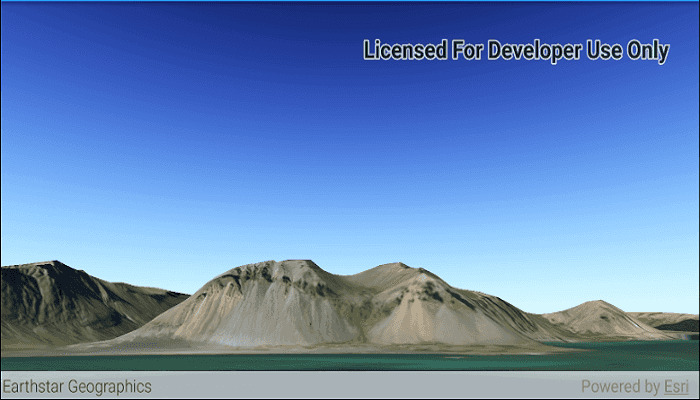Changes the appearance of the atmosphere in a scene.

Use case
Atmospheric effects can be used to make the scene view look more realistic.
How to use the sample
Select one of the three available atmosphere effects. The sky will change to display the selected atmosphere effect.
How it works
- Create an
ArcGISSceneand display it in aSceneView. - Change the atmosphere effect with
sceneView.setAtmosphereEffect(...).
Relevant API
- ArcGISScene
- AtmosphereEffect
- SceneView
Additional information
There are three atmosphere effect options:
- Realistic - A realistic atmosphere effect is applied over the entire surface.
- Horizon only - The atmosphere effect is applied to the sky (horizon) only.
- None - No atmosphere effect. The sky is rendered black with a starfield consisting of randomly placed white dots.
Tags
atmosphere, horizon, sky
Sample Code
MainActivity.java
/* Copyright 2018 Esri
*
* Licensed under the Apache License, Version 2.0 (the "License");
* you may not use this file except in compliance with the License.
* You may obtain a copy of the License at
*
* http://www.apache.org/licenses/LICENSE-2.0
*
* Unless required by applicable law or agreed to in writing, software
* distributed under the License is distributed on an "AS IS" BASIS,
* WITHOUT WARRANTIES OR CONDITIONS OF ANY KIND, either express or implied.
* See the License for the specific language governing permissions and
* limitations under the License.
*
*/
package com.esri.arcgisruntime.sample.changeatmosphereeffect;
import androidx.appcompat.app.AppCompatActivity;
import android.os.Bundle;
import android.util.Log;
import android.view.Menu;
import android.view.MenuInflater;
import android.view.MenuItem;
import com.esri.arcgisruntime.ArcGISRuntimeEnvironment;
import com.esri.arcgisruntime.mapping.ArcGISScene;
import com.esri.arcgisruntime.mapping.ArcGISTiledElevationSource;
import com.esri.arcgisruntime.mapping.Basemap;
import com.esri.arcgisruntime.mapping.BasemapStyle;
import com.esri.arcgisruntime.mapping.Surface;
import com.esri.arcgisruntime.mapping.view.AtmosphereEffect;
import com.esri.arcgisruntime.mapping.view.SceneView;
import com.esri.arcgisruntime.mapping.view.Camera;
public class MainActivity extends AppCompatActivity {
private static final String TAG = MainActivity.class.getSimpleName();
private SceneView mSceneView;
@Override
protected void onCreate(Bundle savedInstanceState) {
super.onCreate(savedInstanceState);
setContentView(R.layout.activity_main);
// authentication with an API key or named user is required to access basemaps and other
// location services
ArcGISRuntimeEnvironment.setApiKey(BuildConfig.API_KEY);
// create a scene and add a basemap to it
ArcGISScene scene = new ArcGISScene(BasemapStyle.ARCGIS_IMAGERY);
// create SceneView from layout
mSceneView = findViewById(R.id.sceneView);
mSceneView.setScene(scene);
// add base surface for elevation data
Surface surface = new Surface();
ArcGISTiledElevationSource elevationSource = new ArcGISTiledElevationSource(getString(R.string.elevation_image_service));
surface.getElevationSources().add(elevationSource);
scene.setBaseSurface(surface);
// add a camera and initial camera position
Camera camera = new Camera(64.416919, -14.483728, 100, 318, 105, 0);
mSceneView.setViewpointCamera(camera);
}
@Override
public boolean onCreateOptionsMenu(Menu menu) {
MenuInflater inflater = getMenuInflater();
inflater.inflate(R.menu.atmosphere_sources, menu);
return super.onCreateOptionsMenu(menu);
}
@Override
public boolean onOptionsItemSelected(MenuItem menuItem) {
// setting different atmosphere effect on scene view
int item = menuItem.getItemId();
if (item == R.id.noAtmosphereEffect) {
mSceneView.setAtmosphereEffect(AtmosphereEffect.NONE);
} else if (item == R.id.realisticAtmosphereEffect) {
mSceneView.setAtmosphereEffect(AtmosphereEffect.REALISTIC);
} else if (item == R.id.horizonAtmosphereEffect) {
mSceneView.setAtmosphereEffect(AtmosphereEffect.HORIZON_ONLY);
} else {
Log.e(TAG, "Menu option not implemented");
}
return super.onOptionsItemSelected(menuItem);
}
@Override
protected void onPause() {
mSceneView.pause();
super.onPause();
}
@Override
protected void onResume() {
super.onResume();
mSceneView.resume();
}
@Override
protected void onDestroy() {
mSceneView.dispose();
super.onDestroy();
}
}